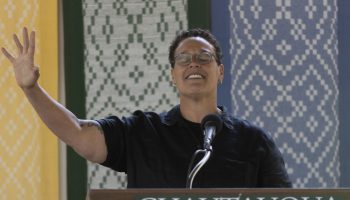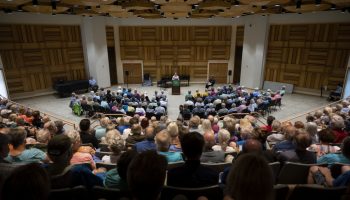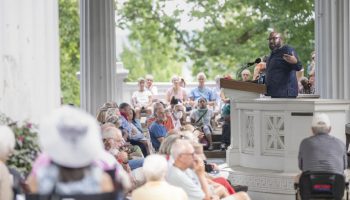MAX ZAMBRANO – STAFF WRITER
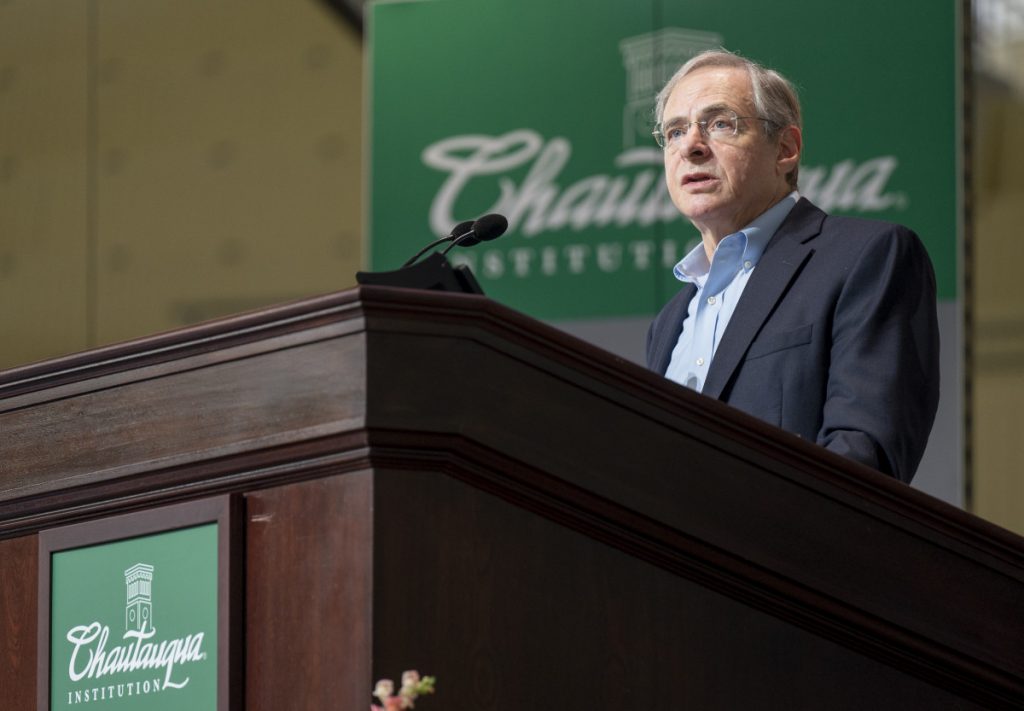
There can’t be anything beyond the physical world. That’s what Bruce Greyson believed growing up in a scientific, materialistic household and into young adulthood.
As he began psychiatric training, patients told him stories about when they nearly died, which he tried to treat with respect, but assumed could not be real.
Then more people told him similar stories. And more. By 1975, his colleague, Raymond Moody, wrote Life After Life, a book that coined the term “near-death experience.” Greyson felt inclined as a scientist to study and research these experiences.
Fifty years later, Greyson has published his findings in his book After: A Doctor Explores What Near-Death Experiences Reveal about Life and Beyond, also the title of his Interfaith Lecture on Tuesday in the Amphitheater, part of Week Eight’s theme “The Human Soul: An Ineffable Mystery.”
“I’ve come to appreciate over the decades how important these experiences are to the experiencers themselves, and to scientists, and to all of us,” said Greyson, who is a professor emeritus of psychiatry and neurobehavioral sciences at the University of Virginia School of Medicine.
Several problems exist in studying near-death experiences, he said. First is a biased sample, in that Greyson and other researchers relied on experiencers coming forward on their own.
“We heard blissful accounts of surviving death and joining deceased loved ones in the afterworld,” he said. “So we assumed these blissful experiences were all there was until years later. We started interviewing everybody in the hospital with a close brush with death, and we started hearing other stories that weren’t the same. Some weren’t very blissful. Others were downright unpleasant.”
Another issue was that people didn’t have the words to describe what happened, he said. Greyson and other researchers then insisted they try metaphors. Some people described long, dark enclosed structures they traveled through to get to the other side, he said. In the West, people might call that a tunnel, while those in the East described a well or a cave.
A third problem is many people are reluctant to discuss their near-death experience, he said. Either people will be afraid of ridicule, being labeled mentally ill, or simply misunderstood. Sometimes they feel it is too sacred or personal to speak of aloud. The next problem was distinguishing these experiences between reality and fantasy.
“We have accounts now from all over the world from different cultures, as well as the Judeo-Christian culture and Hindu, Buddhist and Muslim countries; we have accounts going back from ancient Greece, Rome and Egypt which are essentially the same experience,” he said.
Regardless of religion, culture or time period, people report the same thing, Greyson said.
“I’ve gotten lots of accounts from atheists who said, ‘I don’t believe in God, but there he was,’ ” he said.
Memories of near-death experiences, unlike other memories, remain stable throughout time. Greyson has asked some people to tell the experience again, 30 or 40 years after their first report, and the stories do not change, he said.
“Most near-death experiencers say this experience they had was realer than real,” he said, “that what happened in this other realm or dimension was more real than talking to me right now.”
One scale that measured near-death experiences with memories of dreams, fantasies or things people thought were going to happen but didn’t, demonstrated that these experiences are often more real than memories of real events, he said. Greyson then highlighted some of the common features of near-death experiences.
One is a consistent change in thought processes, he said. People report thinking faster and clearer than ever, no sense of time, a sudden sense of complete understanding, and a review of their entire lives, he said. Sometimes they even see life literally from other people’s perspectives.
Greyson described a 30-year-old man named Tom whose chest was crushed when the truck he was working underneath fell on him. While recalling his entire life, he remembered being a teenager when a drunk man ran out in front of his truck.

Tom was infuriated with the man and rolled down his window to let him know. The drunk man came over and slapped Tom across the face, and Tom got out and beat the man. In his near-death experience, Tom recalled this from the point-of-view of the drunken man.
“He felt his nose getting bloodied, he felt his teeth going through his lower lip, he felt the humiliation of being beaten up by a teenager,” Greyson said.
Near-death experiences also involve a consistent change in feeling and emotions, he said, including an overwhelming sense of peace, well-being, joy, cosmic unity and being one with everything. They report a feeling of unconditional love from a being of light, which Greyson said they often call a divine being. Additionally, there are paranormal features. People see colors and hear sounds they never experienced on earth, including hearing things going on far away and visions of the future.
One day, Al, a man in his mid-50s, had horrible chest pain, Greyson said. After rushing to the emergency room and being evaluated, Al was prepared by doctors for an emergency quadruple bypass surgery. During the operation, he remembered leaving his body and looking down at the room, seeing his open chest and the doctor flapping his arms like a bird.
Greyson thought this was ridiculous and didn’t believe the claim, but Al insisted. Greyson called the surgeon. The surgeon admitted that while watching and supervising assistants, he keeps his hands up to his chest and points to things using his elbows so he won’t touch anything unsterilized.
People also often report seeing another realm or dimension, meeting a mystical being and deceased loved ones. Greyson said as a psychiatrist, he is more impressed with how people’s lives change after near-death experiences.
“I make my living trying to help people change their lives,” he said. “It’s not easy. It takes a lot of hard work over a long period of time. Then, here’s this experience, which often takes seconds or a fraction of a second, which instantaneously seems to transform attitudes, beliefs or values.”
People often report a decreased fear of death or no fear of death whatsoever after near-death experiences, Greyson said, frightening him that these people would become suicidal. He found out, though — by interviewing everyone in his hospital with a suicide attempt — those who reached a near-death experience were now less suicidal than those who didn’t.
“They said they came back from their near-death experience with a sense that there’s a meaning and purpose to everything,” he said.
This same revelation does not occur for those who get close to death but do not have a near-death experience, he said. Those people, instead, are much more afraid of losing their life.
“If a patient has a heart attack and the doctor says, ‘I want you to stop smoking, give up fatty foods,’ the patient says, ‘OK, I don’t want to die,’ ” Greyson said. “If the doctor tells a near-death experiencer that if they don’t give that up they’re going to die, they say, ‘Yeah, so?’ ”
Near-death experiencers also report a decreased need for material possessions, power, prestige, fame and competition, he said, noting they still enjoy them, but are not addicted like many people. Greyson shared one study that showed highly significant changes in attitudes toward spirituality, attitudes toward death, quests for meaning and attitudes toward life. The same study showed, to a lesser extent, changes in concern for others, self-acceptance and concern for worldly goals. The only things that didn’t change were a sense of religiousness and concern for global and societal issues, he said.
An enhanced sense of spirituality is another common effect of near-death experiences. People may still enjoy going to church, he said, but they often report that the God in their near-death experience was much bigger and different than the God taught in church.
With spirituality, people feel much more compassionate to others, seeing everyone as connected, he said, relating it back to the golden rule.

Tom, who beat up the drunk man, realized he was no different from him — they were connected.
“He made (Tom) realize the golden rule is not just a guideline,” Greyson said. “It’s a law of nature.”
Scientists do try to measure spiritual growth, but Greyson qualified none as being that great. Yet one chart showed people who have a near-death experience show high spiritual growth compared to those who almost died but didn’t report a near-death experience. Neither group had a difference in spiritual decline. Better religious well-being, or one’s relationship to the divine, was shown as highly correlated to near-death experiences, while existential well-being, or relationships with people and things, was not significantly changed. With daily spiritual experiences, such as feeling touched by a sunset or beautiful music, people before near-death experiences or getting close to death were not much different. Afterward, those with near-death experiences reported much higher spiritual connections with these daily events, Greyson said.
A similar difference exists between the two groups with a change in spiritual and religious beliefs, he said.
An objective scale of compassionate love, another part of spirituality, showed a strong correlation with near-death experiences. Those who had experiences had changes in caring for others, accepting others and a willingness to sacrifice, he said.
“The more depth there is to the experience, the more spiritual change you feel,” he said.
Near-death experiences also bring about changes in behavior, such as changing relationships or careers.. Take Joe, a policeman who had a near-death experience (not work-related). After he was resuscitated, he realized he couldn’t work a job where he might have to shoot someone. He left the police force, went back to school and became a high school teacher.
Sometimes, people are sad or angry when they return to life.
“They say, ‘This is a miserable place to live, I was great over there, I don’t want to be back here,’” Greyson said. “Some people have problems with other people’s reactions to them. They may feel they’re ridiculed or laughed at by other people, or alternatively they may feel like they’re put on a pedestal by other people.”
Greyson said people argue that near-death experiences are either physical or spiritual. He finds these philosophical questions pointless to his role as a scientist.
In a study that involved brain scans of nuns praying to God, parts of the brain that lit up were interpreted differently. Neuroscientists believed it was the part of the brain that produced an image of God, while the nuns thought it was the part of the brain where God talked to them.
“My viewpoint is you can’t have one without the other,” Greyson said.
He then addressed how the mind and brain interact. He said it’s clear the brain produces thoughts — when intoxicated, it’s harder to think clearly.
“That doesn’t happen in near-death experiences — people whose thinking is clearer than ever and can form memories when brains are not capable of doing that,” he said.
The brain acts as a filter for the mind, he said. One common analogy is trying to listen to every single one of the thousands of radio stations at once. It would be impossible to understand what’s going on, he said, but a radio tuner can single everything down to one radio station. The brain works the same, he said.
Similarly, eyes do not see all of the electromagnetic spectrum, but only the wavelengths that humans need to see to survive, he said. The brain evolved to focus on thoughts needed to survive, he said.
“That raises the question: What is the mind?” he said. “As a scientist, I can tell you I have no idea.”
Humans have always sensed they have a soul, spirit or life force, he said, referencing Ori Soltes’ Monday lecture.
“It’s something we have to believe in,” Greyson said. “Near-death experiencers would say it’s not a matter of belief — it’s experience.”
Greyson then discussed if humans survive bodily death. Al could leave his body when his brain wasn’t functioning, and many say they encountered deceased loved ones. Some debunkers say it’s wishful thinking. Greyson has a counterargument.
Jack, a 25-year-old, was admitted to the hospital with severe pneumonia and repeated respiratory arrest, Greyson said. He was at the hospital for a week and was friendly with his primary nurse. She was leaving for a long weekend, and while she was gone, Jack had another arrest where he needed to be resuscitated.
He had a near-death experience where he ran into the nurse on vacation. She told him to go back to his body, and to tell her parents she was sorry she wrecked the red MGB. Jack woke up and tried to tell another nurse this story, who walked out of the room immediately.
“Turned out, this young nurse had taken the weekend off to celebrate her 21st birthday,” Greyson said. “Her parents surprised her with the gift of a red MGB. She got excited, jumped in the car, took it for a drive, lost control and crashed into a telephone pole and died instantly.”
It was impossible for Jack to know she died, or how. But he met her in his near-death experience, which occurred after her death. Something was still alive and could communicate with Jack, Greyson said. In other stories, people encounter loved ones who died decades ago.
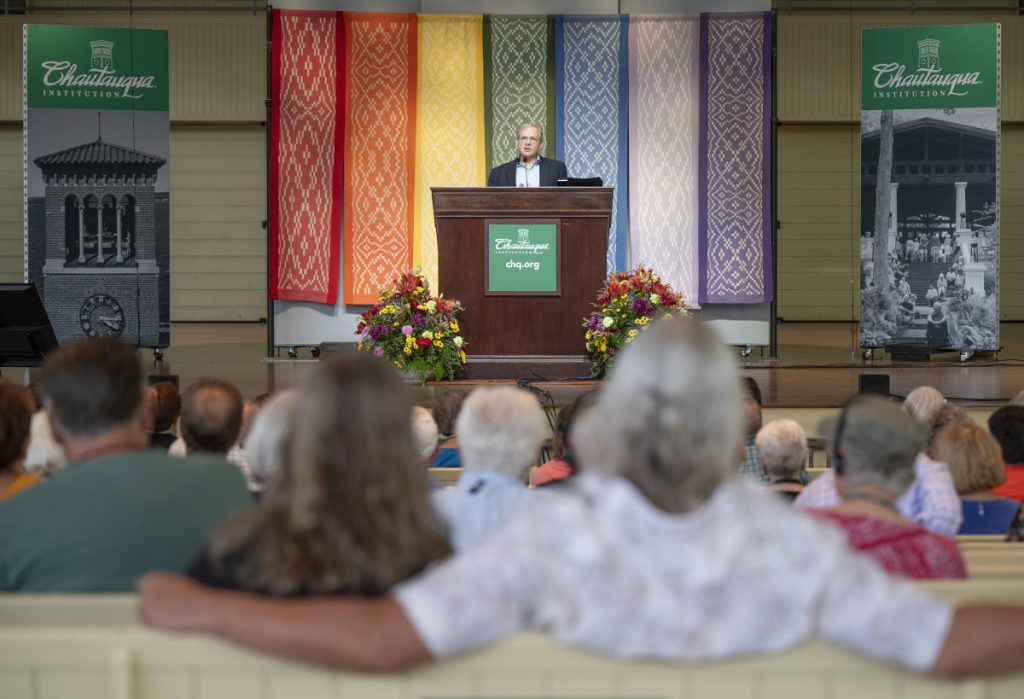
Greyson came back to the problem of metaphors. People cannot describe the warm being of light that radiates unconditional love, but Judeo-Christians may call it God, noting it’s not the God they learned. People from other religions would not use the term “God,” he said.
“Some people who reject the word ‘God’ still believe in some all-powering force or all-powering spirit that guides us all together,” he said.
Also true of the metaphor problem, he said, is the brain cannot process what happened. One person said their memory was flattened or simplified.
“I believe this flattening happens because the human brain cannot understand a world so much more complex and possibly so alien,” he said. “When I read about people having seen streets of gold, it’s amusing, because that would be a flattened example of a complex visual reference.”
Greyson listed six things he wanted people to take away from his lecture. First is that near-death experiences are common — about 5% of people worldwide have had one. Second is that they are normal and not a sign of mental illness. Third is that profound aftereffects must be acknowledged and addressed. Fourth is that the mind can function independently of the brain, meaning fifth, the mind may function beyond death.
Sixth, humans are all interconnected.
“Near-death experiencers, as Tom said, see this golden rule not as a rule we’re supposed to follow, but as a law of nature,” Greyson said. “Living in concert with it makes life much more meaningful and much more fulfilling.”


